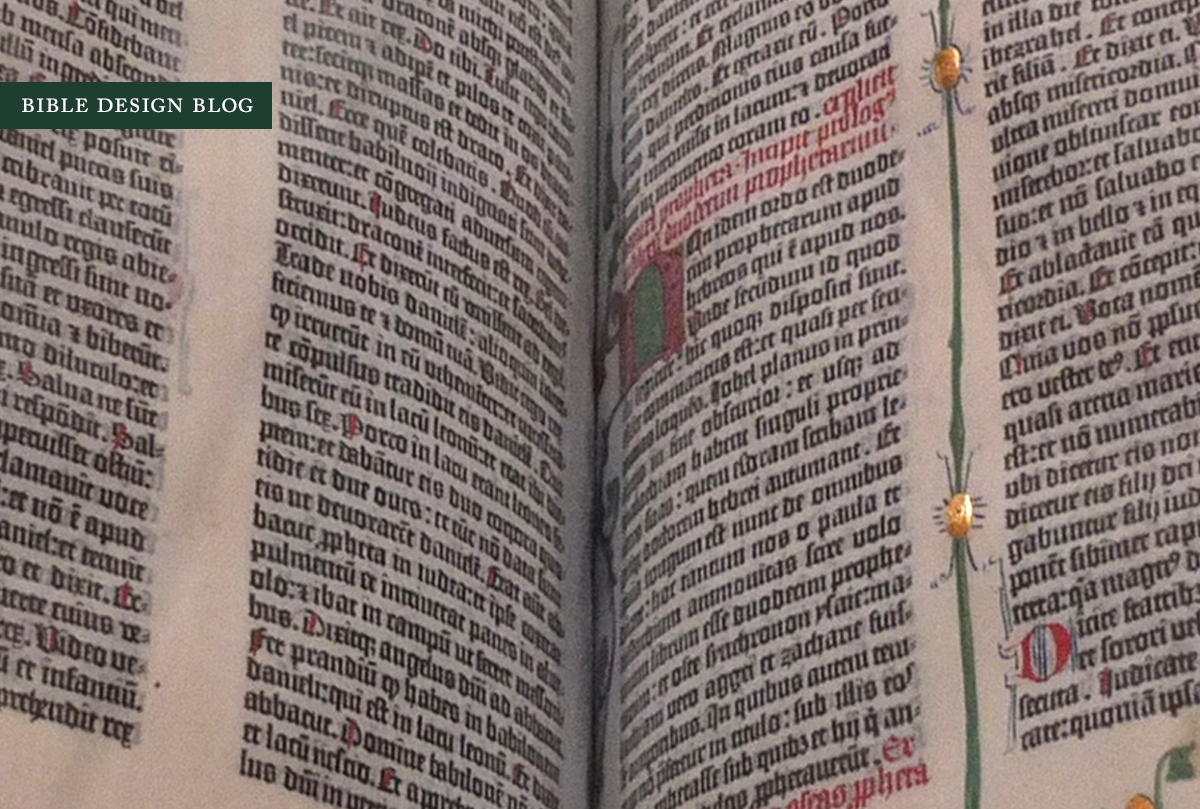Gutenberg Bible (ca. 1455) at the Huntington
BDB Facebook fan page moderator John Blum treated my wife Laurie and I to a day at the Huntington when we were in Pasadena over the summer, where we got up close and personal with a copy of the Gutenberg Bible, the one that started it all. Dated circa 1455, the Huntington's is one of approximately 40-45 copies printed on vellum (of which only a dozen survive). They keep it behind glass, of course, and were not receptive to my suggestion that we take it out to do some Bible Design Blog yoga poses.
 Here's the description given in the exhibit:
Here's the description given in the exhibit:
Gutenberg Bible -- Biblia Latina. Mainz, ca. 1455
The first substantial printed book, the “42-line” Bible is generally thought to have been produced by Johann Gutenberg in Mainz, Germany, between 1452 and 1455. This two-volume work (one is shown here) was intended for churches and monasteries, where the Bible was read aloud to a group of people. The text is that of the Latin Vulgate, and was probably copied from a Parisian manuscript Bible of about 1430.
It is not the first printed work: before it, the same printer published various short texts including calendars, grammars, and religious indulgences. In addition, printing in Asia is known to have existed centuries before Gutenberg, but using different systems.
There is no printed date in the Bible, but a copy in Paris contains a note by Heinrich Cremer that he finished adding the decoration on August 24, 1456. Early documents suggest that between 120 and 130 copies on paper, and 40-45 copies on vellum were assembled. Of these, 12 on vellum (as here) and 36 on paper survive.
The Huntington’s copy contains splendid illumination added by hand and retains its original leather binding, both executed near Leipzig, Germany. Henry Huntington paid $50,000 when he bought the Bible at auction in 1911, then the highest price ever paid for a book.
 Imagine if one of us had shelled out fifty grand on this thing: "For this price point, there should be no ghosting! I can clearly see the print on the reverse of the page, which distracts from readability. Plus, I was disappointed that the binding was so tight. The inside columns disappear into the gutter." Well, let's cut Gutenberg a break. This whole Bible printing thing was pretty new at the time.
Imagine if one of us had shelled out fifty grand on this thing: "For this price point, there should be no ghosting! I can clearly see the print on the reverse of the page, which distracts from readability. Plus, I was disappointed that the binding was so tight. The inside columns disappear into the gutter." Well, let's cut Gutenberg a break. This whole Bible printing thing was pretty new at the time.
 Seriously, it is awe inspiring to be in the presence of such a significant book. Note the substantial binding with metal reinforcement and the raised tabs on the page edges to make finding specific books more easily. Because of the stand the book is displayed on, it's difficult to tell whether the Gutenberg would open flat or not. Clearly intended for heavy use, it's no surprise this copy has survived the centuries in such good shape.
Seriously, it is awe inspiring to be in the presence of such a significant book. Note the substantial binding with metal reinforcement and the raised tabs on the page edges to make finding specific books more easily. Because of the stand the book is displayed on, it's difficult to tell whether the Gutenberg would open flat or not. Clearly intended for heavy use, it's no surprise this copy has survived the centuries in such good shape.

